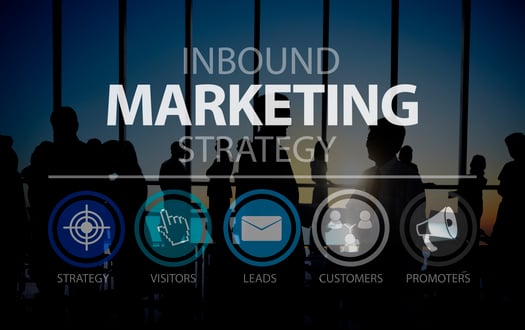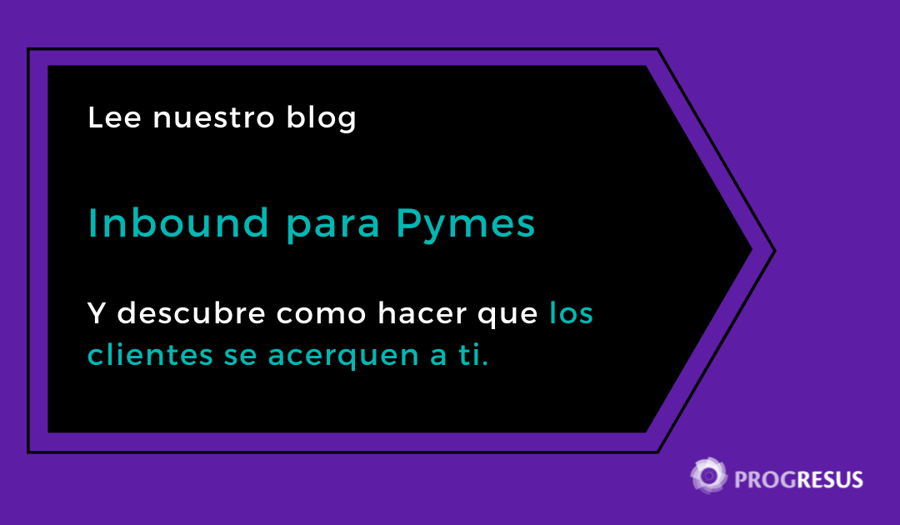One of the biggest challenges that any small business owner faces is constantly finding and attracting new customers to their business.
But what if there was a strategy where, instead of having to search for customers for your business, those customers would find you?
There is a strategy that fulfills that promise, and it's called Inbound Marketing.
Inbound Marketing is undoubtedly one of the most effective digital marketing strategies to drive a steady flow of qualified leads to your business. But what exactly is Inbound Marketing? How does it work? And how can you leverage this content marketing strategy to grow your business?

What is Inbound Marketing and why is it so effective?
Inbound Marketing is a growth strategy that generates leads (and then helps convert those leads into customers) through relevant, targeted, and high-quality content and, when done right, it is one of the most effective marketing strategies for small businesses.
Inbound Marketing is extremely effective for small businesses for several reasons, including:
INBOUND MARKETING BRINGS YOU CUSTOMERS
Other marketing strategies require you to chase leads. But Inbound Marketing brings those customers directly to you, without the need to chase them. The content not only generates qualified leads but also helps you build your reputation within your industry and establish your business as an expert, which can generate even more leads.

INBOUND MARKETING DRIVES MORE LEADS THAN OUTBOUND MARKETING
If you look at it strictly from a "bang for your buck" perspective, Inbound Marketing is more effective than Outbound Marketing strategies. In fact, according to HubSpot, Inbound Marketing delivers 54% more leads into the marketing funnel than traditional outbound leads.
INBOUND MARKETING CONTINUES TO DRIVE LONG-TERM LEADS
With Inbound Marketing, you have to put in the effort to create the content. But once the content is created, it's done. You only have to do the work of creating the content once, but the content will continue to do the work of generating leads for months (or even years!).
Clearly, Inbound Marketing is something you should try for your business. But how do you exactly get started?
Let's take a look at the steps you should follow to develop an Inbound Marketing strategy that will help take your business to the next level:
Discover Your Message
Inbound Marketing is about attracting customers through useful and relevant content. But before you can create that content, you need to discover your Inbound Marketing approaches or, in other words, what you want your content to say.
For your Inbound Marketing strategy to succeed, you need to have a clear message and the desired outcomes that message should generate.
So, for example, if the goal of your Inbound strategy is to get leads to sign up for a free trial of your new product or service, your message should focus on the problem your customers struggle with and how your products or services solve that problem.
If your Inbound strategy is more about establishing your business as a go-to resource in your industry, you'll want your content to build trust and authority, and as such, you would focus your message on education and sharing useful and relevant information.
The point is, if you want your content to resonate with your audience (and generate leads in the process), it's not enough to create something and hope for the best. You need to be very clear about what you're trying to say and what you're trying to achieve with your message.
The clearer your message, the clearer and more specific your content will be, and as a result, the better your content will perform.

Who is Your Message For?
Knowing what you want to say is important, but so is knowing who you want to say it to.
You can't create relevant and targeted content if you don't know who your audience is. Taking the time to define your ideal customer or buyer persona will help ensure that the content you create is relevant and will significantly increase your content's conversion rate.
For example, let's say you want to target technology executives with your Inbound strategy. The type of content you would create to attract and connect with a tech-savvy audience is entirely different from the content you would create if you were targeting mid-level marketing managers, HR directors, or other small business owners.
Defining your ideal customer and buyer persona will ensure that your message is relevant, helpful, and suitable for the audience you're trying to reach.
And the more relevant, helpful, and accurate your content is, the better results you'll achieve with your Inbound Marketing strategy.
Decide What Type of Content You're Going to Create
There are plenty of different ways you can leverage content to generate leads, and a significant part of building a successful Inbound marketing strategy is knowing which types of content you want to focus on.
There's a variety of different content mediums you can leverage for your Inbound marketing strategy, including:
- Blog posts
- E-books
- Case studies
- Customer stories
- Emails
- How-to guides
- Videos
- Audio content (such as podcasts)
- Social media posts
- Webinars
Each Inbound strategy is different; you can decide to focus all your efforts on one or two types of content, or you can decide to leverage multiple forms of content to target your audience.
Either strategy can be effective as long as you make sure to create the type of content that will a) resonate best with your audience, and b) achieve the results you're seeking.
So, for example, if you want your content to persuade business owners to hire your consulting firm, you might consider writing a series of customer stories and leveraging your existing customer base to convince potential clients to work with you (social proof is powerful!).
If you want your content to help establish your company as an authority in your industry (and drive the kind of business that accompanies that authority), you might consider writing long-format educational content (such as blog posts, ebooks, and guides) to showcase your expertise.

Where You're Going to Create That Content
Deciding what type of content you want to create is the first part of the puzzle, but once you've determined what type of content to use, you also need to decide where that content will live.
There are a variety of places where you can share content to generate interest in your business. For example, let's say you decide you want to create blog posts as part of your Inbound strategy. You can host those blog posts on your own website and use that content to capture the contact information and email address of every website visitor, or you can offer to write guest posts on a leading industry blog to get in front of a different, broader audience with potentially more people.
Or let's say you created a series of instructional videos. You can create separate landing pages to host those videos (and drive traffic directly to that landing page to collect lead information), or you can decide to share those videos on Facebook, Instagram, and YouTube and leverage them to generate leads from your social media audience.
Again, think about what you're trying to achieve with your content and then publish it in the place that's most likely to help you achieve those goals, whether it's on social media, your website, or an industry blog.
Discover What Content Is Working in Your Industry and Then Make It Better
When it comes to developing a solid Inbound strategy and creating content that connects with your audience and converts, you don't need to reinvent the wheel. You just have to figure out how to make the wheel better.
The "skyscraper technique" is a content marketing strategy that involves identifying top-performing content in your niche and then figuring out how to improve that content to make it even more valuable.
The skyscraper technique was originally developed as an search engine optimization (SEO)/link-building strategy, but it can be applied just as easily to Inbound strategy.
So, for example, you might notice that one of your competitor's blog posts is gaining a lot of traction with your target demographic. You know the content resonates with your ideal customers, so instead of starting from scratch, you can take the topic or idea from the competitor's blog post and write your own blog post that adds information, insights, and/or resources, and make sure your blog post has even more valuable content than the original.
And because the original post was a hit with your target audience, you know that your blog post, which is even better than the original, is also going to land.
Now, to be clear, you never want to plagiarize or steal someone else's content. With the skyscraper technique, you want to use existing content (that's already performing well in search engines) as inspiration and then find ways to a) improve upon it, and b) put your own spin on it in a way that adds more value for your audience.
Deciding Between In-House or Outsourcing
Another important decision you'll have to make when implementing your Inbound strategy is who will create your content or, in other words, whether you'll handle content internally or hire an external company to create and manage content for you.
There's no right or wrong way to create content; there are advantages and disadvantages to both strategies.
When you hire an external agency or a freelance professional specializing in Inbound, you can leverage their expertise and knowledge to maximize the effectiveness of your marketing and content creation strategy; plus, you get a clear picture of the ROI (how much you invest in outsourcing versus how many leads/customers the outsourcing generates).
But there's always a risk when you outsource something as important as content; you must be very careful when hiring someone who understands your brand, your ideal customers, and what you're trying to achieve with your content.
On the other hand, when you create your content in-house, it's easier to maintain brand consistency and ensure that everyone is on the same page, but if you don't have any content or Inbound Marketing experts on your team, there may be some trial and error before finding the best strategy for your company.
There's no one-size-fits-all approach to content creation; you ultimately have to figure out which strategy, in-house versus outsourcing, is best for your business.
Use the Right Tools
To be as effective as possible with your Inbound strategy, you need the right tools, and that includes tools for creating, optimizing, and analyzing your content and performance.
The right toolkit will depend on your content strategy. For example, if you're going to focus on written content, you can use an insights tool (like BuzzSumo) to identify top-performing content, a grammar tool (like Grammarly or ProWritingAid) to ensure your copy is on point, and an Inbound Marketing tool (like HubSpot) to track the performance of your content and manage your leads.
If you're focused on podcasting, you'll want to invest in audio editing software, professional recording equipment, and a podcast analytics and distribution tool (like Transistor or Podtrac).
The point is, if you want your Inbound strategy to succeed, you need the right tools, so make sure to invest in those tools from the start and set up your strategy for success from the beginning.
Focus on Quality
You might think that Inbound Marketing for SMEs is about generating content 24 hours a day, 7 days a week. But the truth is, it's not so much about the quantity of content you create, but rather how useful and relevant that content is to your audience.
When implementing an Inbound strategy, always prioritize quality over quantity. Remember, the goal of Inbound Marketing is to generate leads, and it's much more likely that those leads will be created by an amazing piece of content per month than if you were to write three mediocre pieces of content per week that don't add any real value to your audience.
So, how do you ensure that you're creating the kind of high-quality content that attracts leads? Before developing or launching content, you'll want to ask yourself:
- How does this content add value to my audience?
- Why would my ideal customer want to read/watch/consume this content instead of other available content on this topic?
- What unique perspective does this content bring to the subject? How does it differ from or is better than similar types of content?
- What problem does this content solve for my ideal customer?
- Is there any way to improve this content before publishing it?
Using these questions to drive the development of your content will ensure that the content you ultimately publish adds significant value to your audience, and that value will ensure that your content generates leads and growth for your business.
Harness Inbound Marketing to Create Stellar Content and Drive Leads for Your Business
Inbound Marketing is one of the most effective strategies to connect with your audience and generate new leads for your business. And now that you know the best practices for creating effective Inbound Marketing strategies from scratch, what's left to do? Go out, develop your strategy, and start harnessing content to generate leads, whether it's from social media, search engine results, or content marketing directly on your company's website.




